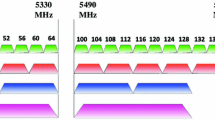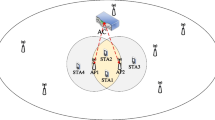Abstract
Overlapping basic service set (OBSS) interferences cause significant reductions in the network throughput as seen at the medium access control (MAC) layer. When the frequency bands of multiple OBSSs are partially overlapped, the reduction of throughput are worsened because in addition to the OBSS interference problem there arises the OBSS-induced spectrum underutilization problem which has not been addressed so far. In this paper, two complementary contention-based MAC layer schemes are proposed to solve the OBSS-induced spectrum underutilization problem by setting up a virtual-primary channel for contention. The proposed time-limited (TL) scheme is designed for transmitting long data packets, which is suitable for applications requiring high throughputs. In contrast, the multi-contention (MC) scheme is designed for transmitting short data packets, which is suitable for applications requiring short delays. By efficiently exploiting the OBSS-induced underutilized spectrum, simulation results verify that the proposed TL scheme can increase the throughput greatly and the proposed MC scheme can reduce the delay for short data packets significantly.










Similar content being viewed by others
References
Goswami, S., Sarmah, K., Sarma, A., Sarma, K. K., & Baruah, S. (2017). Design of a CSRR based compact microstrip antenna for image rejection in RF down-converter based WLAN receivers. AEU: International Journal of Electronics and Communications, 74, 128–134.
Gautam, A. K., Bisht, A., & Kanaujia, B. K. (2016). A wideband antenna with defected ground plane for WLAN/WiMAX applications. AEU: International Journal of Electronics and Communications, 70(3), 354–358.
Ansal, K. A., & Shanmuganantham, T. (2015). A novel CB ACS-fed dual band antenna with truncated ground plane for 2.4/5 GHz WLAN application. AEU: International Journal of Electronics and Communications, 69(10), 1506–1513.
Hu, S., Li, J., & Pan, G. (2014). Performance and fairness enhancement in IEEE 802.11 WLAN networks. AEU: International Journal of Electronics and Communications, 68(7), 667–675.
Monteiro, T. L., Pellenz, M. E., Penna, M. C., Enembreck, F., & Pujolle, G. (2012). Channel allocation algorithms for WLANs using distributed optimization. AEU: International Journal of Electronics and Communications, 66(6), 480–490.
Zheng, Y., Shi, T., Xu, X., et al. (2017). Research on WLAN planning problem based on optimization models and multi-agent algorithm. In IEEE international conference on cybernetics and intelligent systems (CIS) and IEEE conference on robotics, automation and mechatronics (RAM) (pp. 249–254).
Soni, G., & Verma, C. (2017). Performance investigation of the WLAN link using QAM and QPSK based on vector signal transceiver 5644R. In 7th international conference on communication systems and network technologies (CSNT) (pp. 34–37).
Lepaja, A., Maraj, A., et al. (2018). The impact of the security mechanisms in the throughput of the WLAN networks. In 7th Mediterranean conference on embedded computing (MECO) (pp. 1–5).
Jovičić, K., Koprivica, M., et al. (2017). Experimental analysis of electromagnetic radiation originating from 802.11a/g WLAN devices. In 25th telecommunication forum (TELFOR) (pp. 1–4).
Gebreyohannes, F. T., Frapp, A., & Kaiser, A. (2016). A configurable transmitter architecture for IEEE 802.11ac and 802.11ad standards. IEEE Transactions on Circuits and Systems II: Express Briefs, 63(1), 9–13.
Chung, C., Jung, Y., & Kim, J. (2015). Saturation throughput analysis of IEEE 802.11ac TXOP sharing mode. Electronics Letters, 51(25), 2164–2166.
Hu, Z., & Wen, X. (2015). Modeling the TXOP sharing mechanism of IEEE 802.11ac enhanced distributed channel access in non-saturated conditions. IEEE Communications Letters, 19(9), 1576–1579.
Aajami, M., & Suk, J. B. (2015). Optimal TXOP sharing in IEEE 802.11ac. IEEE Communications Letters, 19(7), 1141–1144.
Yuxia, L., & Wong, V. W. S. (2006). Saturation throughput of IEEE 802.11e EDCA based on mean value analysis. In Wireless communications and networking conference.
Hyunduk, K., Gwangzeen, K., Kim, L., et al. (2013). Overlapping BSS interference mitigation among WLAN systems. In 2013 international conference on ICT convergence (ICTC) (pp. 913–917).
Bo, H., Lusheng, J., Seungjoon, L., et al. (2009). Channel access throttling for overlapping BSS management. In IEEE international conference on communications, 2009 (ICC ‘09) (pp. 1–6).
Wu, J., & Jiang, T. (2014). A novel scheme to ease the problem of OBSS networks based on admission control and TPC. In 14th international symposium on communications and information technologies (ISCIT) (pp. 588–592).
Yin, Y., & Jiang, T. (2014). A new admission control scheme/or the overlapping BSS issues in the 802.11 WLANS. In 14th international symposium on communications and information technologies (ISCIT) (pp. 583–587).
Kang, H., Ko, G., Kim, I., et al. (2014). Interference mitigation among neighbor APs using 802.19.1 coexistence service: Information service vs. management service. In 2014 international conference on information and communication technology convergence (ICTC) (pp. 711–716).
Han, Q., Yang, B., et al. (2014). Multi-leader multi-follower game based power control for downlink heterogeneous networks. In 2014 33rd Chinese control conference (CCC) (pp. 5486–5491).
Abinader, F. M., Almeida, E. P. L., C houdhury, S., et al. (2014). Performance evaluation of IEEE 802.11n WLAN in dense deployment scenarios. In IEEE 80th vehicular technology conference (VTC fall) (pp. 1–5).
Ropitault, T. (2018). Evaluation of RTOT algorithm: A first implementation of OBSS_PD-based SR method for IEEE 802.11ax. In IEEE 15th annual consumer communications & networking conference (CCNC) (pp. 1–7).
Kanda, M., Katto, J., & Murase, T. (2016). Enhancement of HCCA utilizing capture effect to support high QoS and DCF friendliness. In IEEE 13th annual consumer communications & networking conference (CCNC) (pp. 335–338).
IEEE Std 802.11ac™-2013, “IEEE standard for information technology: Telecommunications and information exchange between systems local and metropolitan area networks specific requirements, Part 11: Wireless LAN medium access control (MAC) and physical layer (PHY) specifications amendment 4: Enhancements for very high throughput for operation in bands below 6 GHz”, December 11, 2013.
Stelter, A. (2013). Efficient access to extended channel bandwidth in wireless LAN. Electronics Letters, 49(21), 1356–1358.
Acknowledgements
This work was supported in part by the Important National Science & Technology Specific Projects (2013ZX03003013-005).
Author information
Authors and Affiliations
Corresponding author
Additional information
Publisher's Note
Springer Nature remains neutral with regard to jurisdictional claims in published maps and institutional affiliations.
Appendix
Appendix
1.1 Time–Frequency Resource Ratio Analysis
The time–frequency resource is defined as the product of occupied/available time and bandwidth. Then, the time–frequency resource ratio (TFRR) of a MAC protocol can be defined as the ratio between the time–frequency resource needed to transmit some data frames using a direct link and the total time–frequency resource used to transmit these data frames under the MAC protocol.
1.2 TFRR of 802.11ac Protocol
Assume there are NS STAs (including AP) contending for the channel access in a BSS and each STA has the same probability to access the channel. If only one data frame is transmitted for each channel access, then M frames are transmitted during a given time when there are M times of successful channel accesses for all STAs in the BSS. Let pn be the probability that an STA in the BSS is a 20n megahertz capable STA, where n (n = 1, 2, …, N) is the number of 20 MHz channels that the STA can operate on. In 802.11ac, when the available bandwidth in the BSS is 80 MHz, the total number of available channels N is 4. Then, in average, Mpn data frames are transmitted by the NSpn 20n megahertz capable STAs in the BSS during the given time duration.
Let LMPDU be the MAC protocol data unit length in bytes, TS be the orthogonal frequency-division multiplexing (OFDM) symbol duration, m be the modulation and coding scheme (MCS) index and Lm,n be the number of data bits that can be transmitted per OFDM symbol over n 20 MHz channels corresponding to an MCS with index m. If the number of bits in the service field plus tail field of the physical layer convergence protocol data unit is ntail, the transmission time for each data frame (without considering the transmission time of the preamble) is
where ⌈·⌉ represents round toward positive infinity. Then, the total time–frequency resource needed to transmit the M data frames (with MCS m) using a direct link is
However, the total time–frequency resource used to transmit these M data frames in 802.11ac is
where \({\text{T}}_{\text{p}}\) is the preamble duration, \({\text{T}}_{\text{DIFS}}\) is the distributed coordination function inter-framing spacing (DIFS) time and \({\text{T}}_{\text{SIFS}}\) is the short-inter-frame-spacing (SIFS) time. The average backoff time is assumed to be equal to \({\bar{\text{T}}}_{{\rm B}} = {\text{T}}_{{\rm slot}} {\text{CW}}_{{\rm min} } /2\), where CWmin is the minimum contention window size and Tslot is the slot duration. (Since we use CWmin to calculate the backoff time, the TFRR to be defined later will be denoted as maximum TFRR). The transmission times for RTS, CTS and ACK frames are given by TRTS = TP + Tm,n(LRTS), TCTS = TP + Tm,n (LCTS) and TACK,n = TP + Tm,n(LACK). Here, LRTS, LCTS and LACK, denoting the number of bytes for RTS, CTS and ACK frames respectively. Then
1.3 TFRR of the TL Scheme
Without loss of generality, we assume that MCS m2 is adopted over the first i 20 MHz channels and MCS m1 is adopted over the left N − i 20 MHz channel to transmit more data when the first i 20 MHz channels are occupied by the neighbor BSS in the TL scheme. Let LSNI denote the number of bytes for SNI, TSNI = TP + Tm,n(LSNI). Then, the total bytes transmitted over the left N − i 20 MHz channels is
It is illustrated in Fig. 11. Then the total time–frequency resource needed to transmit the data frames (with MCS m2) using a direct link is
where
The total time–frequency resource used to transmit these data frames using TL scheme is
Then
1.4 TFRR of the MC Scheme
Assuming that there are NMC times of successful channel accesses over the left N − i 20 MHz channels (with MCS m2) during the transmission time \({\text{T}}_{{{\text{m}}_{2} ,{\text{i}}}} \left( {{\text{L}}_{\text{MPDU}} } \right)\) of the first i 20 MHz channels (with MCS m1), the total bytes transmitted over the left N − i 20 MHz channels is
It is illustrated in Fig. 12. Then the total time–frequency resource needed to transmit the data frames (with MCS m2) using a direct link is
where
However, the total time–frequency resource used to transmit these data frames using MC scheme is
Then
where \({\hat{\text{T}}}_{{{\text{m}}_{1} ,{\text{m}}_{2} ,{\text{n}}}}^{\text{i}} \left( {{\text{L}}_{\text{MPDU}}^{\text{MC}} } \right)\) is given by (14).
For convenience and without loss of generality, consider that the AP and the STAs in BSS1 and BSS2 are 80 MHz and 20 MHz capable devices respectively. Assuming the probability that the primary channel occupied by BSS2 is p, then p1 = p, p2 = 0, p3 = 0 and p4 = 1 − p1 = 1 − p. The minimum and maximum contention window sizes are 15 and 1023, respectively. MCS index m1 = m2 = 1 is used for data transmission. TS = 4 μs, ntail = 22 bytes, \({\text{T}}_{\text{p}} = 40\;\upmu{\text{s}}\), \({\text{T}}_{\text{DIFS}} = 34\;\upmu{\text{s}}\), \({\text{T}}_{\text{SIFS}} = 16\;\upmu{\text{s}}\) and Tslot = 9 μs. We assume that the transmitted frame length is 3000 bytes when the channel is accessed over primary channel. Table 3 shows the TFRR of the proposed scheme and 802.11ac protocol. Obviously, the TFRR of TL scheme is highest which is in line with the intuition. Just considering the results for MC scheme, we observe that the TFRR decreases as NMC increases. This is due to the fact that the bigger the NMC is, the larger the proportion of the overhead is.
Rights and permissions
About this article
Cite this article
Guo, Y., Lu, IT., Fang, J. et al. MAC Layer Approaches for Mitigating the Spectrum Underutilization Due to Overlapping BSS Problem in WLAN. Wireless Pers Commun 105, 293–311 (2019). https://doi.org/10.1007/s11277-018-6113-7
Published:
Issue Date:
DOI: https://doi.org/10.1007/s11277-018-6113-7






